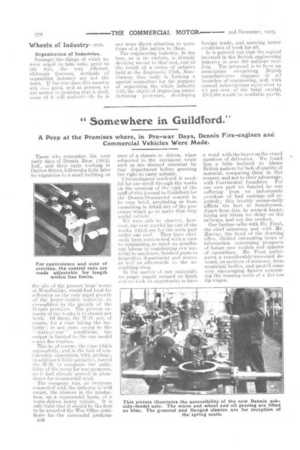"Somewhere in Guildford,"
Page 10

If you've noticed an error in this article please click here to report it so we can fix it.
A Peep at the Premises where, in Pre-war Days, Dennis Fire-engines and Commercial Vehicles Were Made.
Those Avho remember the very early days of Dennis Bros. (1013), Ltd., and their early working in Onslow Street, followed a little later by expansion to a small building on
the site of the present large woms at Woodbridge, would find food for reflection on the very rapid growth of the heavy-vehicle industry, as exemplified by the growth of the Dennis premises. The present capacity of the works is 31 chassis per week. Of these, the W.D. are, of course, for a time taking the majority; in any ease, owing to the.
state-of-war " conditions, the output is limited to the one model —and fire-engines.
This is, of course, the ype which successfully, and in the face of considerable opposition, with, perhaps, in addition a little prejudice, forced fin W. 1). to recognize the suitability of the worm for war purposes, as it. had already proved in abundance for commercial work.
The, company was, as everyone connected with the industry is well aware, the pioneer in the production, on a commercial basis, of a worm-driven heavy vehicle. It is only right that it should be the first to be awarded the War Office certificate for the successful .perform. B36 anee of a chassis so driven, when subjected to the strenuous trials such as are deemed essential by that department before granting the right to carry subsidy. Circumstances rendered it needful for oar stroll through the works on the occasion of the visit of the staff of this journal to Guildford for the Dennis-Drummond concert to he very brief, precluding us from examining in detail any of the processes which go to make that very useful vehicle.
We were able to observe, however, the very careful lay-out of the works, which are for the main part under one roof. They have obviously been constructed with a view to minimizing as much as possible any labour in transferring raw material to machines, finished parts to inspection department and stores, as well as afterwards to the assembling shop. In the matter of raw materials, an ample supply seemed on hand, ..nd we took an opportunity to have a word with the buyer on the vexed question of deliveries. We found him a little inclined to blame British makers for lack of quality of material, comparing them in this respect, and not to their advantage, with Continental foundries. For our own part we fancied he was suffering from an unfortunate overdose of bad castings (all rejected); this trouble occasionally afflicts the best of foundrymen. Apart from this, he seemed happy, laying any blame for delay on the railways, and not the vendors.
Our further talks with Kr. Frost, the chief salesman, and with Mr. Murray, the head of the drawing office, elicited interesting items of information concerning prospects of future new models and spheres of operations. Mr. Frost anticipates a considerably-increased demand, on motives of economy, from municipal bodies, and quoted some very encouraging figures concerning the running costs of a, five-ton. tip-wagon.




















